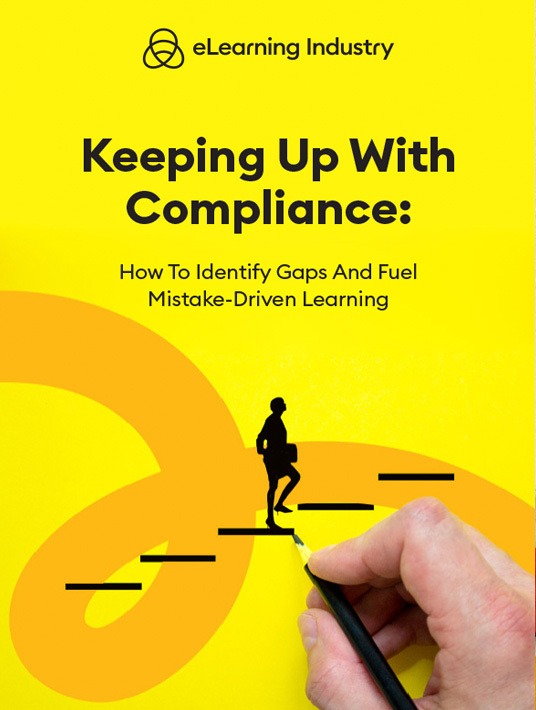Which Risks Should You Address In Compliance Training Online Courses?
What are the most relevant risks and how do you prep your team with compliance training online courses? Due to the pandemic, compliance is more important than ever. As there are new issues staffers must be aware of to prevent contagion and ensure workplace safety. However, there’s not enough time (or cognitive space) to address every hazard employees might encounter on-the-job. But there are a few topics that ALL compliance training programs should address. Regardless of your industry, employee background, or business objectives. So, what are the most common challenges to incorporate into your L&D strategy?

7 Workplace Risks To Cover In Compliance Online Training
1. COVID-19 Safety
It’s on the forefront of everyone’s minds. Thus, it should be at the top of your compliance training to-do list. COVID-19 safety topics range from social distancing to proper gear. Your employees work remotely, but there are times when they may have to come into contact with clients. For example, they’ve scheduled an on-site meeting and need to know which gear to wear. What should they do to prep for travel? If they work in remote call centers, what are the protocols for interacting with co-workers?
2. Data Security
Data safety is one of the most common compliance risks in the digital era because virtually everything happens online. Employees send sensitive documents and collaborate with peers from afar. They also collect information from clients and customers. All of these tasks leave them vulnerable to attacks. Such as hacking and data breaches. So, how can they keep records safe and deter hackers? What happens if there is a potential breach in your firewall or if someone has accessed the database without authorization? Who should they report it to and what are the protocols?
3. COI Breaches
Conflict of interest is one of the most challenging compliance topics because it has gray areas. For example, what constitutes a client bribe? Is it ethically wrong to hire a friend or family member, even if they are the most qualified candidate? Thus, some of the best training activities are real-world-centered. Such as simulations, branching scenarios, and demos that explore the many nuances of COI compliance. As these resources allow employees to differentiate right from wrong in a practical context. Instead of just reading about all the rules and drawing their own conclusions.
4. Harassment
Harassment takes many forms in the modern workplace. From cyberbullying to sexual misconduct. Employees don’t have to be in the same physical space to feel harassed. For instance, a co-worker might make an off-colored joke during a live event that makes them uncomfortable. Or a client sends them ten emails a day that are completely off-topic and they start prying into their personal lives. As such, your anti-harassment compliance online training course should cover the entire spectrum. Outline all the policies and protocols so that staffers know how to identify harassment and report it to their superiors.
5. Work-Related Injuries
Since your team works remotely, the usual workplace accidents probably don’t apply. For instance, they don’t have to worry about heavy machinery or slippery floors. The exception is geographically dispersed staffers who work in remote sites. Such as call centers and retail stores. For the most part, work-related injuries center on repetitive strain and improper ergonomics. As an example, they sustain a wrist injury or back pain because they don’t take frequent breaks. Or maybe their posture contributes to the issues. Thus, you need to assess physical risks and then create personalized compliance training resources. Ask them to map out their workday and track how long they spend on the computer or workstation. Then identify the potential hazards based on their duties and roles.
6. Emergency Preparedness
In many ways, the pandemic has changed how we define ‘emergencies.’ As most of us never even considered global outbreaks a possibility, outside of sci-fi movies, of course. Staffers need to be ready for any emergency that comes their way. Whether it’s a fire, natural disaster, or pandemic-related incident. Some of the best training tools are demos, simulations, and serious games. As well as tutorials that teach them how to handle unexpected events without buckling under pressure. It’s also best to create a microlearning library to address the most common emergencies. For example, a five-minute video clip that highlights evacuation procedures. Or what to do if another lockdown is ordered and they need to telecommute at the last minute.
7. Company Policy Breaches
Another risk to consider for your compliance online training program is policy violations. These rules and guidelines are in place to ensure employee safety in all its forms. That includes physical, emotional, and mental well-being. As well as to maintain a positive brand image. Therefore, it’s essential to raise awareness of policies that tie into their work tasks and departments. Then emphasizes the importance of compliance and all the consequences involved. For instance, what happens if they don’t follow the protocols and a co-worker is injured? Don’t just give them generalizations. Make it personal so that they know how all the rules and regulations pertain to their roles and responsibilities.
Conclusion
The challenge that many organizations face is the ticking clock. You need to train your team now so that they avoid all the common pitfalls. As such, one of the main reasons to hire an outsourcing partner for your compliance online training courses is fast turnaround times. You need to address these issues ASAP to mitigate risks and keep everyone safe on the job. Check out our free online directory to find the right compliance training vendors for bespoke or off-the-shelf solutions.
Download the eBook Keeping Up With Compliance: How To Identify Gaps And Fuel Mistake-Driven Learning to leverage mistake-driven learning for compliance and spot hidden gaps in your strategy.

